VolcanoCam Images Archive
| Archive Home | Hall of Fame Images | Download Eruption Movies | View Online Eruption Movies |
Download Eruption Movies and Photograph Sets
The VolcanoCam recorded its first-ever images of Mount St. Helen erupting. We have five sets of images as well as VolcanoCam movies of these eruptions available for downloading. All images are in the .jpg file format. The movies are in the .avi, .mov, and .wmv file formats.
| Download Information | |
| File Format | Description |
| .avi | Available at two frame speeds ( 2 fps and 6 fps), in a zipped file. |
| .mov | Available at two frame speeds ( 2 fps and 6 fps), in a zipped file. |
| .wmv | Available within a self-extracting .exe file and in a zipped file. |
| .jpg | A complete still image set used to create the movies. |
| October 01, 2004 Eruption Images | |
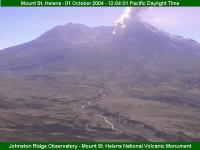 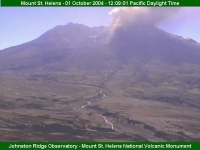 |
USGS Mount St. Helens Information Statement Shortly before Noon today, Mount St. Helens emitted a plume of steam and minor ash from an area of new crevasses in the crater glacier south of the 1980-86 lava dome. The event lasted from 11:57 to 12:21 PDT and created a pale-gray cloud that reached an altitude of about 9,700 feet (from pilot reports). It drifted southwestward, where nearby residents should receive no more than a minor dusting of ash. USGS scientists making thermal measurements witnessed the emission and noted that the clouds were not particularly hot. Blocks of rock and ice ejected by the event fell in the crater and rim areas. The emission was accompanied by an abrupt drop in seismicity, which remains at low levels.
|
| October 04, 2004 Eruption Images | |
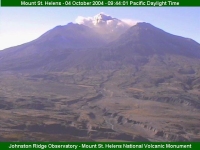 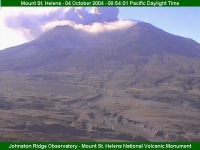 |
USGS
Mount St. Helens Information Statement This morning visitors to Mount St. Helens witnessed a 40-minute-long steam-and-ash emission starting at 9:43 PDT. Steam clouds carrying minor ash billowed out of the crater to an altitude of 10,000 to perhaps 12,000 feet. The event did not generate earthquakes or an explosion signal. We infer that hot rock was pushed up into the glacier, melted ice, and generated the steam. Part of the vent for today’s and other steam and ash emissions of the past few days is now covered by a boiling lake. The emission occurred during a time of gradually increasing seismicity, which dropped slightly after the emission, but continued to increase gradually through the afternoon. Another period of smaller steam and ash bursts occurred between 2:10 and 2:40 P.M. Visual observations show that the area of uplift, which includes part of the glacier and a nearby segment of the south flank of the lava dome, continues to rise. We infer that magma is at a very shallow level and could soon be extruded into the vent or elsewhere in the deforming area. Additional steam and ash emissions are likely and could occur at any time without warning. Conditions suggest that there is also an increased probability of larger-magnitude and more ash-rich eruptions in coming days.
|
| October 05, 2004 Eruption Images | |
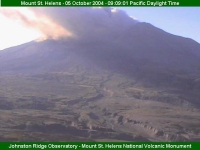 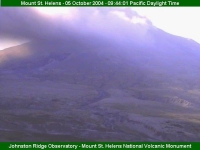 |
USGS
Mount St. Helens Information Statement This morning the rate of seismicity was at a high, sustained level when, shortly after 9:00 a.m. PDT, the most vigorous steam and ash emission of the current period of unrest began. The emission originated from the same vent as have others this past week, as well as from another nearby new vent in the intensely deforming area on the south side of the 1980-86 lava dome. For more than one hour, steam clouds billowed from the crater. The ash content varied with intensity of steam jetting from the vent. For the first time, ash content was sufficient that it was detected by National Weather Service Doppler Radar. Steam and ash clouds reached about 12,000 feet and drifted north-northeastward. Ash forecasts warned downwind residents. Media reports indicate that a light dusting of ash fell in Morton, Randle, and Packwood, Washington, towns about 30 miles from the volcano. Nearby traffic on U.S. 12 stirred up the ash, slightly reducing visibility. We have no reports of ash falling at greater distances. The rate of seismicity dropped during and the emission and has stayed at a relatively low rate. We infer that magma is at a very shallow level and could soon be extruded from a vent in the deforming area. Additional steam and ash emissions are likely and could occur at any time without warning. Conditions suggest that there is also an increased probability of larger-magnitude and more ash-rich eruptions in coming days.
|
| October 10, 2004 Eruption Images | |
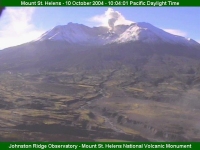 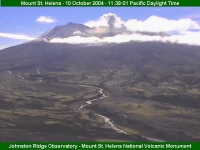 |
USGS
Mount St. Helens Information Statement Seismic activity has decreased slightly over the past 20 hours to low levels, similar to those observed during the evening hours of October 7. Earthquakes continue to occur at a rate of about 1 per minute, but most have magnitudes of 1.0 or less. With the improving weather, a gas measuring flight is planned within the next two days. Additional analysis of lidar and photographs of the intensely uplifting area on the south side of the lava dome suggests that the total volume change represented by the deformation between late September and October 6 is about 16 million cubic meters (21 million cubic yards). The average rate of change is about 2 million cubic meters per day (2.6 million cubic yards per day). If this figure represents the rate of intrusion of magma into shallow levels of the dome and(or) underlying crater floor, it is an intrusion rate about twice that measured during dome-building eruptions at Mount St. Helens in the 1980s. Cartographers with the USGS office in Denver are working to develop precise volume change estimates for the uplifted area from stereo airphotos acquired between 1 and 5 October. As a result of the intense unrest of the past 11 days, we infer that magma is at a very shallow level. During times of unrest, Mount St. Helens and similar volcanoes elsewhere typically go through episodic changes in level of unrest over periods of days to weeks, or even months. Such changes are in part driven by variations in the rate of magma movement. We expect fluctuations in the level of unrest to continue during coming days. Escalation in the degree of unrest and perhaps an eruption could occur suddenly or with very little warning. There may be little time to raise the alert level before a hazardous event occurs. Therefore, we continue to monitor the situation closely and will issue additional updates and changes in alert level as warranted.
|
| October 11, 2004 Eruption Images | |
 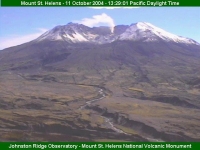 |
USGS
Mount St. Helens Information Statement Seismic activity remained at a low level overnight. Small earthquakes (maximum about magnitude 1) continue to occur at a rate of about 1 per 5 to 10 minutes. Visual observations and thermal imaging of the crater, the 1980-86 lava dome, and the intensely deforming and uplifting area on the south side of the dome were made yesterday afternoon. Thermal imaging of the western part of the uplifting area revealed temperatures of 500 to 600 degrees C on a large pinkish-gray fin of rock and in nearby fumaroles and cracks. These observations are consistent with new lava having reached the surface of the uplift. Additional visual and thermal observations will be made today to further evaluate this interpretation. A gas-sensing flight yesterday measured fluxes of sulfur dioxide and carbon dioxide that are similar to or slightly smaller than those measured on 7 October. The next gas-sensing flight is scheduled for tomorrow.
|